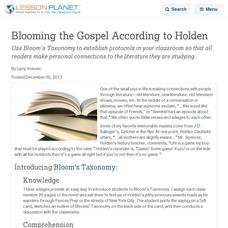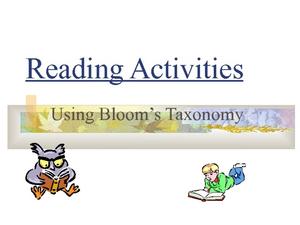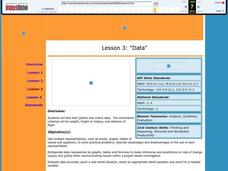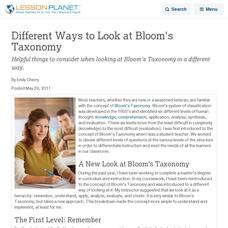Curated OER
Review with Creative Writing
Connect a wide range of literature concepts where writers demonstrate mastery through creative writing.
Curated OER
Blooming the Gospel According to Holden
Use Bloom's Taxonomy to establish protocols in your classroom so that all readers make personal connections to the literature they are studying.
Curated OER
Maus: Cubing Questioning Strategy
Maus is the text for a postreading activity that has class members using a cubing strategy to analyze, in depth, topics (racism, past and present, forgetting/remembering the Holocaust, representing the Holocaust) associated with Art...
Curated OER
Bloom's Taxonomy for Ethan Frome: Chapter Four
As your class progresses through Chapter four of Ethan Frome, provide them with these thought-provoking questions built using Bloom's Taxonomy.
Curated OER
Jumping Off the Bandwagon
Teach your class to be critical consumers by studying persuasion in advertising.
Curated OER
Ordinary People: Cubing Strategy
Readers of Ordinary People employ a cubing strategy based on Bloom’s Taxonomy to analyze, from multiple perspectives, an excerpt from Chapter 10 of Judith Guest’s novel. The excerpt, a rationale and complete directions for the activity...
Curated OER
Mississippi Trial, 1955: A Request Strategy for Questioning
Knowledge, comprehension, application, analysis, synthesis, evaluation. Class members use Bloom's taxonomy to craft six levels of discussion questions for Chris Crowe's novel, Mississippi Trial, 1955. Model questions from Chapter 3, a...
Curated OER
And the Streets Are Paved With Gold
Students explore immigrant experience at Ellis Island, New York, at the turn of the century, and answer questions that challenge them to use thinking skills from various levels of Bloom's taxonomy.
Curated OER
Things Fall Apart: Bloom's Taxonomy of Thinking Processes
One of the things that makes Bloom's Taxonomy so effective is that it works off different levels of understanding. Test your readers' knowledge, comprehension, application, analysis, synthesis, and evaluation with these short questions....
Curated OER
The Joy Luck Club: Bloom's Taxonomy: Questions
Really challenge your class when they're reading Amy Tan's The Joy Luck Club. Provide them with this list of six thought-provoking questions to encourage a deeper analysis. The questions are based off of Bloom's Taxonomy, and a list of...
Curated OER
Fahrenheit 451: Questioning Strategy
After reading Captain Beatty's speech (pg. 54-63) in Fahrenheit 451, provide your class with these analysis questions. Six questions are included here, using Bloom's Taxonomy to focus on knowledge, comprehension, application, analysis,...
Curated OER
Population Biology Case Study
Students are focused on the big question: What makes a population grow and how could that growth stop? They use these concepts to help answer the big question: carry capacity, density dependent v. density, independent factors, predation...
Curated OER
Body Biography: The Lion, the Witch and the Wardrobe
Class groups assume the identity of one of the primary human characters in The Lion, the Witch and the Wardrobe. They create a body biography that identifies the most important traits of their character, translate these traits into...
Curated OER
Novel Study: The End of the Line
The End of the Line, Angela Cerrito's gripping novel about an adolescent murderer incarcerated in an unusual "school," is the subject of a comprehensive set of support materials. Chapter vocabulary and discussion questions are excerpted...
Curated OER
Forming Open-Ended Questions
Help readers learn to create their own open-ended questions for any text you are working with. Using Bloom's Taxonomy, learners begin on the lower levels and work their way up to form questions that focus on synthesis instead of simple...
Curated OER
Reading Activities Using Bloom's Taxonomy
This short, yet effective, presentation gives pupils many great tips on increasing their enjoyment of what they read and improving their comprehension. The categories of tips include analyzing, remembering, understanding, applying,...
Manchester University
Where The Forest Meets The Sea
Join a father and his son as they explore an isolated location off the coast of Australia in the children's book Where the Forest Meets the Sea by Jeannie Baker. Engage young learners in reading this fun story with this series of...
Curated OER
Data
Students collect data from an experiment they perform. In this data lesson, students use multiple representations to solve practical problems; describe advantages and disadvantages of the use of each representation. Then, they evaluate...
Curated OER
Different Ways to Look at Bloom's Taxonomy
Here's a new way to look at Bloom's Taxonomy.
Curated OER
Gallery Walk Questions about Energy and Material Cycles
Students state the physical, chemical or biological processes associated with these environments: Pelagic ocean zone, California coat Cave, Indiana Barrier island beach, North Carolina Sand dune, Dunes National Park, Colorado Wetland and...
Curated OER
Magnets and Interactions
Second graders discover what magnets can do. In this magnet instructional activity students make predictions about magnets. They experiment with the magnets and record their data on a chart.
Curated OER
Questions About Rivers
Students investigate rivers. In this geography lesson, students work in cooperative groups to read about rivers from articles they have collected. Students form questions using Bloom's Taxonomy as a guide.
Curated OER
Cooperative Learning Groups Cooperate
Pupils apply Bloom's Taxonomy to reading selections. They prepare questions for each level of Bloom's Taxonomy and exchange them with other groups to answer. They answer another group's questions and report to one another.
Curated OER
Stones, Bones & Telephones: Analyzing Artifacts Using Bloom's Taxonomy
Seventh graders define metacognition, Bloom's Taxonomy, and artifacts. They, in groups, try to identify a mystery artifact using the Artifact Analysis sheet. They present their findings to the class.

























